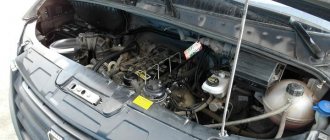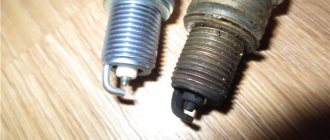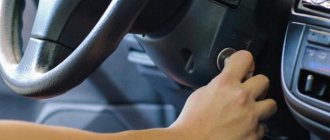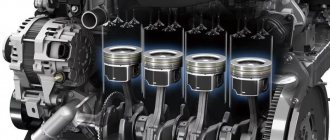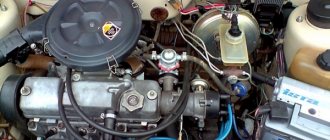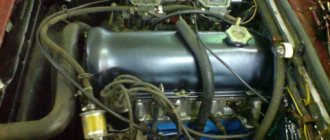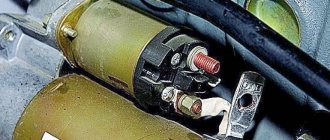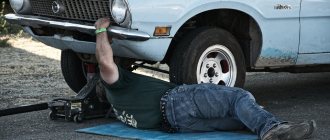Sooner or later, any owner of a Gazelle Business or Next with a Cummins diesel engine may encounter a problem - the car will not start. You need to go on a flight, but the car is parked and it’s not clear what happened, because everything seemed to be fine.
What to do in this case? Let's try to understand the main reasons for this phenomenon and what needs to be done to eliminate them.
Let's say right away that we will not consider such obvious reasons as lack of fuel in the tank and a dead battery. We really hope that your driving experience is enough to independently identify and eliminate these causes.
Gazelle with a Cummins engine won't start?
Call and get a free consultation from our specialist!
8-800-100-24-93
free call from mobile
Intake air heating coil
For the fuel mixture to ignite, it must be at a certain temperature. And in order for the mixture to reach the desired temperature, Cummins ISF 2.8 engines have an element called an intake air heating spiral (candle).
This engine element starts working at low temperatures. It is located in the engine intake manifold and starts working after turning the ignition key. In principle, in the summer, when it’s warm outside, you can do without this detail. But on frosty days, starting the engine with the intake air heater not working will be very problematic.
Therefore, in the cold season, the first thing you need to do is check whether the intake air heating coil is working. This is easy to do - when the spiral is running, the intake manifold should be warm.
It is necessary to inspect the contacts of the spiral and the wires going to them. It often happens that the wires simply break. But sometimes it happens that the spiral itself fails. In this case, only replacing it will help.
What to do if the Gazelle stalls while driving?
If the Gazelle stalls while driving, then the first thing you need to do is look at the fuel, or rather its supply.
It is necessary to inspect the engine compartment for fuel leaks. It happens that due to vibrations, the fixing bracket unscrews and the tube from the injection pump to the ramp bursts.
Even a small crack in the tube will be enough for the pressure in the system to drop and the engine to stop working. This phenomenon is usually accompanied by a yellow check.
If everything is in order with the tube from the injection pump to the ramp, we recommend continuing to inspect the fuel system and pay attention to the fuel filter housing. Sometimes it happens that its top cover fails and air begins to leak through it.
Disassembly and assembly of K151D
All repair work on the carburetor unit is carried out in a dry room, on a clean table, where there are no foreign objects (only the necessary tools and devices). When disassembling we remove:
- top cover (held on by seven screws)
- to completely dismantle it, it is also necessary to disconnect the telescopic suction rod;
- then we remove the top gasket, it can be replaced in any case, unscrew the side plug screw, remove the axle, remove the float from the chamber;
- the float must be without external damage and without gasoline inside (to determine this, you need to shake it);
- we remove the needle of the locking mechanism, it can be removed here freely;
- Next, we unscrew the GDS (main dosing system) jets; the fuel jets are located at the bottom, inside the chamber, the air jets are at the top;
- each jet has its own marking, and when replacing them, you need to install strictly in their places those parts that correspond to the parameters;
- Next, we remove the accelerator pump nozzle, the primary/secondary chamber diffusers (we pry them off very carefully, trying not to damage them anywhere, and there are also small gaskets installed there);
- unscrew the four screws of the accelerator pump diaphragm housing; if the diaphragm is not even torn, but has lost elasticity, it is better to replace it immediately;
- turn the case over, unscrew the two screws securing the lower part with the throttle valve, the screws are located almost in the middle;
- between the housings there are two thin and one thick gaskets, it is also advisable to change them immediately;
- All that remains is to unscrew the three screws securing the forced idle economizer housing (EFS), and at this point the main disassembly can be considered complete.
If you need to change the transition system jets, then you should also unscrew the side plugs.
When replacing parts using a repair kit, under no circumstances should the jets be mixed up; they have a certain calibration, and if they are installed incorrectly, the engine will operate unstably and fuel consumption will increase. Two screws in the main body (pictured below) are adjusting (one is the needle of the accelerator pump in the drainage channel, the second is the valve regulator of the same system, there is a ball inside the channel). The side screws located next to the diffusers are the XX air jets (main and additional (second)) and the transition system.
Clogged intake tube in the tank, air or fuel filter
Another reason that your Gazelle with a Cummins engine does not start may be a clogged fuel or air filter.
When the fuel filter is clogged, we do not receive the required amount of fuel, and when the air filter is clogged, there is correspondingly little air. If the car jerks or there are dips in dynamics, check all filters. They need to be changed at least once every 15,000 km.
GAZelle starter: device, malfunctions, repairs
Sooner or later, any owner of a Gazelle Business or Next with a Cummins diesel engine may encounter a problem - the car will not start. You need to go on a flight, but the car is parked and it’s not clear what happened, because everything seemed to be fine.
What to do in this case? Let's try to understand the main reasons for this phenomenon and what needs to be done to eliminate them.
Let's say right away that we will not consider such obvious reasons as lack of fuel in the tank and a dead battery. We really hope that your driving experience is enough to independently identify and eliminate these causes.
If you require original spare parts for the Cummins ISF 2.8 engine, you can always purchase them in our online store.
Call and get a free consultation with a specialist right now!
8-800-100-24-93
free call from mobile
The starter does not respond to turning the key
If you turn the ignition key and the starter does not respond at all, then you need to look for a problem in the wiring and power fuses. Power fuses need to be inspected and checked very carefully, because they may look intact, but in fact they are broken. To understand for sure, you need to unscrew each fuse.
It could also be due to faulty wiring or a bad ground. It is necessary to check and clean the negative connections.
Ignition system problems
The first signs of a problem also appear when the engine stalls when you press the gas. If the driver suspects problems with the ignition, then this guess is quite easy to check. You need to unscrew the spark plug, and if it is wet, then your suspicions are most likely confirmed. This is due to the fact that when you press the gas pedal sharply, the spark plugs fill, then they fill and the spark becomes very weak.
This type of breakdown can be double-checked using a new set of spark plugs, or you can look under the hood at night with the engine running. If there is damage to the wires, then you can notice with the naked eye a “spark” from current discharges in problem areas.
If you have just such a problem and you do not have experience in repairing your car yourself, then it is best to seek help from a good auto mechanic.
Air leak
Very often, the cause of poor engine starting can be a banal air leak. From our experience, it most often occurs through the intake pipe in the tank or through a failed separator cover. To check for air leaks in the fuel system, it is necessary to replace the fuel pipe from the filter to the injection pump with a transparent hose.
Bubbles in the fuel will immediately indicate the presence of air leaks. As we have already said, it is necessary to check the separator cap and the intake pipe in the tank, as well as all connections of the fuel pipes.
Problems with the power system
Another reason when the engine stalls when you press the gas may be incorrect operation of the power system. Completely different things can cause such violations, but most often it is low-quality fuel. Various impurities that are added to such a surrogate can lead to blockages in various components of the power system, namely filters, injectors, etc. Provided that the blockages are not severe, failures in engine operation will be quite rare. As the blockages increase, there may come a time when starting the engine becomes simply impossible. Determining the presence of this particular reason is quite simple:
To prevent these problems from arising in the future, it is necessary to be more careful when choosing gas stations.
Another reason for the engine stalling when you press the gas pedal may be poor ventilation in the fuel tank. This can happen if the drain tube is clogged. This problem is very easy to identify. You just need to open the gas tank and start the engine. If the engine stops stalling, then simply clean the drainage.
How to check injectors on a Gazelle with a Cummins ISF 2.8 engine yourself
In order to independently check whether the injectors are draining into the return line, you need to use ordinary medical syringes. For more information about this, watch Denis Gorban’s video
If the injectors are delivering too much fuel to the cylinders, the fuel mixture will not be correct and the fuel will not burn completely, causing you to see thick black smoke coming from the exhaust.
Thick black smoke may also be due to a clogged air filter, but if the cause lies in the injectors, we recommend that you stop using the vehicle immediately. Otherwise, due to too high a temperature in the combustion chamber, the engine may overheat or the piston may melt, which in turn will lead to expensive overhauls.
Faulty injection pump
The reason that the car does not start may be a breakdown of the high pressure fuel pump. The injection pump fails due to the following reasons:
- poor quality fuel;
- water and dirt in fuel;
- long-term operation of the car with air leaks.
The first two reasons for fuel pump failure are obvious. Why does the fuel injection pump break down due to air leaks? The fact is that modern common rail system pumps do not have a separate lubrication system and are lubricated with diesel fuel.
And when there is air in the fuel, the injection pump begins to run “dry”, which is why the friction between the pump elements increases significantly and over time it begins to drive metal shavings.
These metal shavings can cause fuel injectors to fail over time. If you need to turn the starter for a long time to start the engine and if the engine runs unevenly and with vibrations, then most likely this indicates an air leak.
In order not to destroy the fuel system and avoid expensive repairs, we recommend eliminating this air leak as soon as possible.
Also, the cause of poor starting of the internal combustion engine can be a jammed check valve on the fuel injection pump. This happens rarely, but it does happen. Therefore, we recommend that you check it as well.
Causes of malfunction
If the starter turns poorly when the battery is charged, then the breakdown, in most cases, is in the engine starting device.
The reason for the low engine speed, in this case, may be:
Before you begin to identify the above reasons, you should make sure that the battery produces sufficient current to start the engine. To do this, you can use a load fork. If the battery is serviceable, it is necessary to measure the density of the electrolyte.
Wiring faults
The starter of an internal combustion engine is the most energy-intensive piece of electrical equipment in a car, so poor-quality fastening of wires and terminals can reduce the efficiency of this device.
The current strength that occurs when the starter is turned on is so high that an electric arc can form in wires that are not well attached. Part of the energy will be spent on maintaining this effect, as a result of which the starter will rotate very slowly.
In addition to insufficient current in the circuit, an electric arc can lead to a fire, so if the battery does not turn the starter well, you should first inspect the battery connection terminals, and also check the quality of the connection of the positive wire, which is connected from the “+” battery to the solenoid relay.
You should also check the cable that connects the engine housing to the car body; there may also not be good enough contact in this place.
In addition to electrical leakage and loose nuts and bolts, the starter may lack electrical power due to oxidation of the battery terminals. In this case, a layer is formed of a substance that poorly conducts electric current, which is the reason for the deterioration of the starter’s performance.
This problem can be easily solved if you use a soda solution to remove the resulting oxidation layer:
- To prepare the solution, use ordinary soda and warm water in a ratio of 1 to 10.
- You can use a rag to clean the terminals, but the most suitable tool for this job is an old toothbrush.
Defective solenoid relay
A very common breakdown that can cause poor performance of the car’s starting mechanism.
If a short circuit occurs in the electromagnet winding, then this part will need to be completely replaced, but in most cases the reason for the unsatisfactory operation of the solenoid relay is a malfunction resulting from burning of the relay contacts.
In order to restore the functionality of the device, it is necessary to remove the solenoid relay from the starter housing and remove the ebonite cover to which the wires are connected.
Inside the device, there will be a copper plate that closes the relay contacts. It is this part that is most damaged. The surface of the plate that comes into contact with the contacts must be cleaned of irregularities that arise due to elevated temperatures during contact closure. To do this, you should use a velvet file, but remove the metal very carefully so that the plate does not become too thin, otherwise there will not be good contact between the electrical conductors.
The contacts located on the ebonite cover of the solenoid relay also need to be cleaned. To carry out this operation, you need to unscrew the bolts to which the wires are connected and clean them on the side where they come into contact with the contact plate. The surface of the bolts is cleaned with a file. It is necessary to remove a minimum amount of metal so that the contacts are in sufficient contact with the contact plate of the electromagnet.
When cleaning of the contacts is completed, assembly and installation of the solenoid relay is carried out in the reverse order. The bolts of the retractor relay must be well fixed in the ebonite housing, but the threaded connection should not be twisted, otherwise the fragile material of the cover of this device may be damaged.
Low compression
If the engine throws oil out through the breather or consumes it in large quantities, and the operation of the car is accompanied by bluish smoke with a characteristic burning smell, then most likely the internal combustion engine has problems with the piston group and in particular with the piston rings.
When the piston group wears out in the cylinders, compression drops and therefore, again, the pressure in the cylinders necessary to start the engine will not be created. In such cases, only a major overhaul of the internal combustion engine will save you.
Electronics problems
Modern car models today have very sophisticated electronics that completely control the entire operation of the vehicle. If the engine starts to stall when you press the gas pedal, you should more carefully monitor the operation of many sensors. It is through them that information about the activities of all automobile systems passes, and the failure of any of them will inevitably lead to incorrect operation of the engine. You will need to check the sensors:
The most common problem is with the throttle sensor. Here the engine stalls regularly when you press the gas and often completely unexpectedly for the driver.
Only an experienced specialist can determine exactly which sensor began to supply incorrect information to the ECU using special equipment. Not all sensors that fail need to be replaced immediately; you can try to clean them and continue using them.
